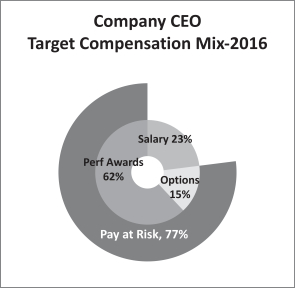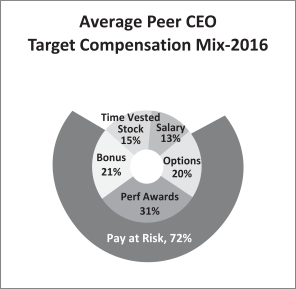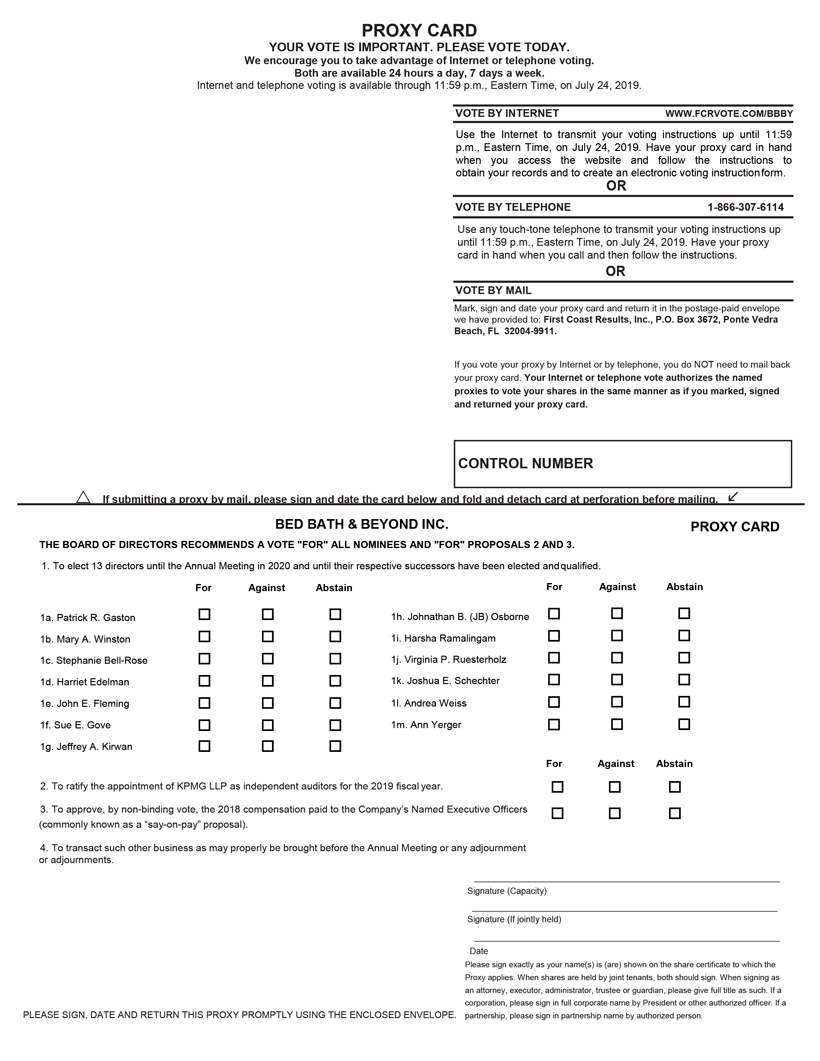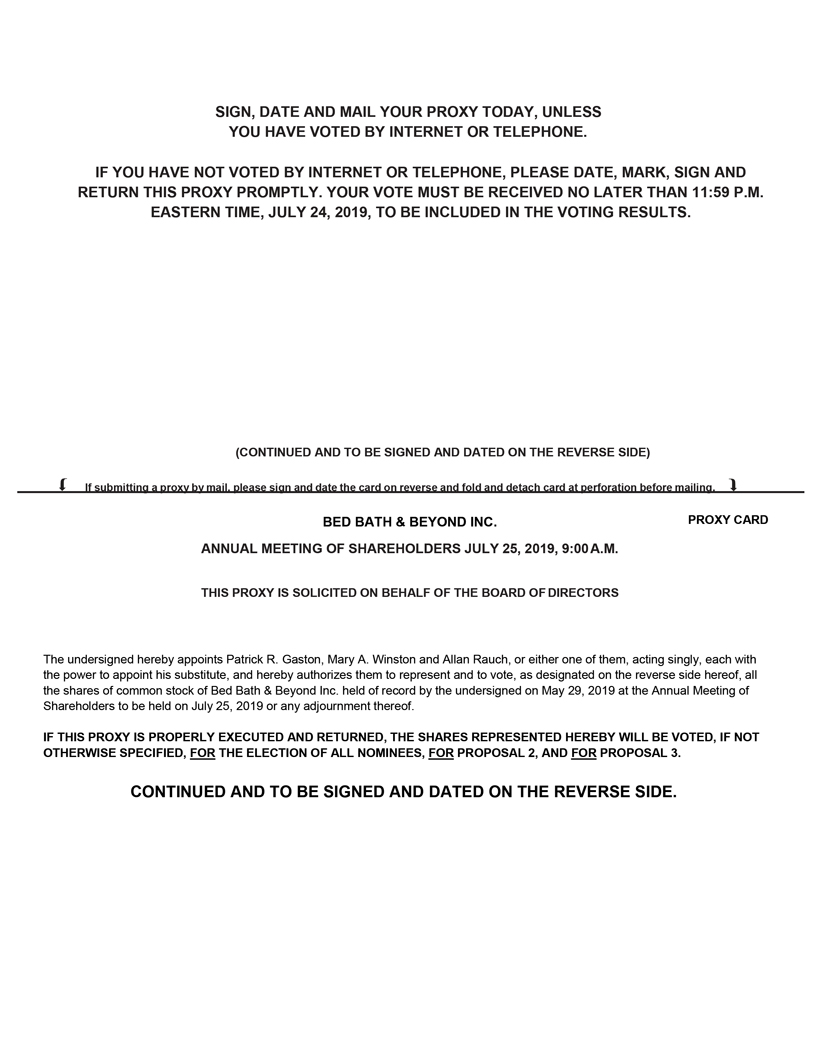PROPOSAL 4—ADVISORY VOTE ON FREQUENCY OF FUTURE ADVISORY VOTES ON EXECUTIVE COMPENSATION
In accordance with the requirements of Section 14A of the Securities Exchange Act of 1934, the Company is seeking the input of its shareholders on the frequency with which it will hold a non-binding, advisory vote on the compensation of its Named Executive Officers (commonly known as a “frequency of say-on-pay” proposal). In voting on this Proposal 4, shareholders are provided with four choices. Shareholders may indicate their preference as to whether the advisory vote on the compensation of the Company’s Named Executive Officers (NEOs) should occur once every (i) one year, (ii) two years, or (iii) three years; or the shareholders may abstain from voting on this Proposal 4.
After careful consideration, it is the opinion of the Board of Directors that the frequency of the shareholder vote on the compensation of the Company’s NEOs should be once every one year. The Board of Directors recommends an annual advisory vote because an annual vote will allow shareholders to provide direct input on the Company’s compensation policies and practices, and the resulting compensation for the NEOs, every year. Shareholders would have the opportunity to consider the Company’s most recent compensation decisions in the context of its pay for performance philosophy and focus on increasing long-term shareholder value, and to provide feedback to the Company in a timely way.
While the Board recommends an annual vote, shareholders are not voting to approve or disapprove of the Board’s recommendation. Rather, shareholders are being provided with the opportunity to cast an advisory vote on whether the shareholder advisory vote on executive officer compensation should occur once every (i) one year, (ii) two years, or (iii) three years, or to abstain from voting on the matter.
As an advisory vote, this proposal is not binding on the Company. Notwithstanding the advisory nature of this vote, the Board of Directors values the opinions expressed by shareholders in their vote on this proposal, and will consider the outcome of the vote when making a determination as to the frequency of future advisory votes on executive compensation. The alternative (every one year, two years or three years) receiving the majority of votes cast will be the frequency that shareholders approve. If no alternative receives a majority of votes cast, then the alternative receiving the greatest number of votes will be deemed the frequency that shareholders approve.
THE BOARD OF DIRECTORS RECOMMENDS THAT THEOUR SHAREHOLDERS
VOTE ON AN ADVISORY BASIS, FOR A FREQUENCY OF SAY-ON-PAY VOTE
OFONCE EVERY ONE YEAR.
PROPOSAL 5—RE-APPROVAL OF THE PERFORMANCE GOALS UNDER THE COMPANY’S 2012 INCENTIVE COMPENSATION PLAN
Shareholders are being asked to re-approve the performance goals under the Bed Bath & Beyond Inc. 2012 Incentive Compensation Plan (the “2012 Plan”). The 2012 Plan was initially adopted by the Board of Directors as the 2004 Incentive Compensation Plan on May 13, 2004 and was thereafter approved by our shareholders at the 2004 Annual Meeting of Shareholders. The 2004 Incentive Compensation Plan was thereafter amended, restated and renamed the 2012 Incentive Compensation Plan, which was approved by the Board of Directors on May 18, 2012 and by our shareholders at the 2012 Annual Meeting of Shareholders.
The purpose of asking shareholders to re-approve the performance goals under the 2012 Plan is so that certain incentive awards granted thereunder may qualify as exempt performance-based compensation under Section 162(m) of the Internal Revenue Code of 1986, as amended (the “Code”). Section 162(m) of the Code generally disallows the corporate tax deduction for certain compensation paid in excess of $1,000,000 annually to each of the chief executive officer and the three other most highly paid executive officers (other than the chief financial officer) of publicly-held companies, unless compensation is performance-based or satisfies other conditions. To satisfy the performance-based exception, Section 162(m) of the Code generally requires such performance goals to be approved by shareholders every five years.
We are not proposing any amendment to the terms of the 2012 Plan at this time. These performance goals must be shareholder approved to preserve, to the extent possible, our tax deduction for certain awards made under the 2012 Plan in accordance with the terms of Section 162(m) of the Code and the related regulations.
The Board recommends that shareholders re-approve the performance goals under the 2012 Plan. If the requisite shareholder approval of the performance goals is not obtained, we may continue to grant awards under the 2012 Plan in accordance with its current terms. However, certain awards under the Plan may not constitute “performance-based” compensation under Section 162(m) of the Code and accordingly, may not be tax deductible by the Company depending on the facts and circumstances.
The following description of the 2012 Plan is summary of its principal provisions. Please also refer to the complete copy of the 2012 Plan, which was filed as Exhibit A to our definitive 2012 Proxy Statement on Schedule 14A filed with the SEC on May 24, 2012.
Description of the 2012 Plan
Administration
The Board of Directors has appointed two committees to administer the 2012 Plan: the Compensation Committee which is authorized to grant awards to executive officers and certain other key executives; and a second committee, consisting of the Co-Chairmen and Chief Executive Officer, which is authorized to grant awards to other employees and consultants. All members of the Compensation Committee are intended to be “non-employee directors” within the meaning of Rule 16b-3 under the Exchange Act, “outside directors” within the meaning of Section 162(m) of the Code and “independent directors” under NASDAQ Listing Rule 5605(a)(2). Under the 2012 Plan, the entire Board of Directors has the authority to grant awards to non-employee directors.
Eligibility and Types of Awards
Employees, consultants and prospective employees and consultants of the Company and its affiliates and non-employee directors of the Company are eligible to be granted non-qualified stock options, SARs, restricted stock awards, performance awards and other stock-based awards under the 2012 Plan. Only employees of the Company or its subsidiaries are eligible to be granted incentive stock options (“ISOs”) under the 2012 Plan. Eligibility for awards under the 2012 Plan is determined by the applicable Committee in its sole discretion, provided that no award may be made to any non-employee director unless all similarly situated non-employee directors have the right to receive the same award on the same terms.
Available Shares
The aggregate number of shares of common stock of the Company that may be issued or used for reference purposes under the 2012 Plan may not exceed 43,200,868 shares (which includes 14,300,000 shares approved in 2012 by shareholders plus 19,000,000 shares approved by shareholders in 2004 plus shares of common stock that were available for grant under the 1996, 1998, 2000 and 2001 Stock Option Plan). As of May 5, 2017, 15,205,511 shares of common stock of the Company remained available for grant under the 2012 Plan, taking into account grants thereunder as well as cancellations and forfeitures. This share reserve remains in effect through the remainder of the 2012 Plan’s term (due to expire May 18, 2022).
PROPOSAL 5—RE-APPROVAL OF THE PERFORMANCE GOALS UNDER THE COMPANY’S 2012 INCENTIVE COMPENSATION PLAN
Shares of common stock that are subject to stock options or SARs will be counted against the overall limit as one share for every share granted. If any stock option or SAR is cancelled, expires or terminates unexercised for any reason, the shares covered by such award will again be available for the grant of awards under the 2012 Plan, except that any options or SARs that are not issued as the result of a net settlement or that are used to pay any exercise price or tax withholding obligation will not be available for the grant of awards. Shares of common stock repurchased on the open market by the Company with the proceeds of an option exercise price also will not be available for the grant of awards. Shares of common stock that are subject to other types of awards will be counted against this limit as 2.2 shares for every share granted. If such other awards are forfeited for any reason, 2.2 shares will again be available for the grant of awards under the 2012 Plan that we granted after the 2012 Annual Meeting of Shareholders and 1.80 shares will again become available for the grant of awards made under the 2012 Plan that were granted prior to the date of the 2012 Annual Meeting of Shareholders.
The maximum number of shares of common stock subject to any option and/or SAR that may be granted under the 2012 Plan during any fiscal year of the Company to each employee is, in the aggregate, 1,000,000 shares. The maximum number of shares of common stock subject to any restricted stock award and/or other stock-based award that is subject to the attainment of specified performance goals that may be granted under the 2012 Plan during any fiscal year of the Company to each employee is 750,000 shares. The maximum number of shares of common stock subject to any performance award denominated in shares of common stock that may be granted to an employee under the 2012 Plan attributable to any year of a performance period is 750,000 shares. The maximum payment that may be made to an employee under the 2012 Plan and denominated in dollars for a cash-based award attributable to any year of a performance period is $5,000,000. The above per-participant limits will be increased for an employee to the extent that awards made to the employee in any prior year under the 2012 Plan were for less than the maximum number of shares or the amounts permitted to be granted, in the aggregate, to the employee.
The Committee may, in accordance with the term of the 2012 Plan, make appropriate adjustments to the above limits and the terms of outstanding options and other awards to reflect any stock dividend or distribution, stock split, reverse stock split, recapitalization, reorganization, merger, consolidation, split-up, combination, reclassification, or exchange of shares, partial or complete liquidation, issuance of rights or warrants, sale or transfer of the Company’s assets or business, or any special cash dividend (or any other event affecting the Company’s capital structure or business).
On May 5, 2017, the closing price of a share of common stock on the Nasdaq Stock Market was $37.34.
Awards under the 2012 Plan
Stock Options. The 2012 Plan authorizes the Committee to grant ISOs (only to eligible employees) and non-qualified stock options to purchase shares of common stock. The Committee will determine the number of shares of common stock subject to each option, the term of each option, the exercise price (which may not be less than the fair market value of the common stock at the time of grant, or 110% of fair market value in the case of ISOs granted to 10% shareholders), any vesting schedule, and the other material terms of each option. Options will be exercisable at such times and subject to such terms as are determined by the Committee at grant. The maximum term of options under the 2012 Plan is eight years (or five years in the case of ISOs granted to 10% shareholders). Options with vesting conditions based on the attainment of performance goals will be exercisable no earlier than one year after grant and options with vesting conditions based on the continued service of the recipient will be fully exercisable no earlier than three years after grant (permitting pro-rata vesting over such three year period), subject to acceleration of vesting in the event of a change in control, retirement, death or disability, at the discretion of the Committee. However, up to 5% of the shares reserved for issuance may be granted without these minimum vesting requirements. Upon the exercise of an option, the recipient must make payment of the full exercise price, either: in cash, check, bank draft or money order; solely to the extent permitted by law, through the delivery of irrevocable instructions to a broker reasonably acceptable to the Company to deliver promptly to the Company an amount equal to the aggregate purchase price; or on such other terms and conditions as may be acceptable to the Committee (including, without limitation, the relinquishment of options or by payment in full or in part in the form of common stock).
Stock Appreciation Rights. The 2012 Plan authorizes the Committee to grant SARs either in tandem with an option or independent of an option. The exercise price of a tandem SAR will be the exercise price of the related option. A SAR is a right to receive a payment either in cash or common stock equal in value to the excess of the fair market value of one share of common stock on the date of exercise over the exercise price per share of the SAR. The Committee will determine the terms and conditions of SARs at the time of grant, but generally SARs will be subject to the same terms and conditions as options (as described above).
Restricted Stock Awards. The 2012 Plan authorizes the Committee to grant restricted stock awards. Recipients of restricted stock awards enter into an agreement with the Company subjecting the restricted stock awards to transfer and other restrictions and providing the criteria or dates on which such awards vest and such restrictions lapse. The restrictions on
PROPOSAL 5—RE-APPROVAL OF THE PERFORMANCE GOALS UNDER THE COMPANY’S 2012 INCENTIVE COMPENSATION PLAN
restricted stock awards may lapse and the awards may vest over time, based on performance criteria or other factors (including, without limitation, performance goals that are intended to comply with the performance-based compensation exception under Section 162(m) of the Code), as determined by the Committee at grant. For restricted stock awards that vest or whose restrictions lapse based on the attainment of performance goals, the minimum restriction or vesting period will be no less than one year after grant, and for restricted stock awards that vest or whose restrictions lapse based on the continued service of the recipient, the restriction or vesting period will be no less than three years after grant (permitting restrictions to lapse or awards to vest pro-rata over such three year period), subject to the earlier vesting or lapsing of restrictions in the event of a change in control, retirement, death or disability, at the discretion of the Committee. However, up to 5% of the shares reserved for issuance may be granted without these minimum vesting requirements or restriction periods. Except as otherwise determined by the Committee, a recipient of a restricted stock award has all of the attendant rights of a shareholder, including the right to receive dividends, if any, subject to vesting conditions as described below, the right to vote shares and, subject to and conditioned upon the vesting and restrictions lapsing for all of shares, the right to tender such shares. The right to receive dividends on a restricted stock award is subject to the vesting or lapsing of the restrictions on the restricted stock award.
Performance Awards. The 2012 Plan authorizes the Committee to grant performance awards entitling recipients to receive a fixed number of shares of common stock or cash, as determined by the Committee, upon the attainment of performance goals with respect to a designated performance period. Unless the Committee determines otherwise at grant, the minimum performance period will be one year.
Other Awards. The 2012 Plan authorizes the Committee to grant awards of common stock and other awards that are valued in whole or in part by reference to, or are payable in or otherwise based on, common stock, including but not limited to: shares of common stock awarded purely as a bonus in lieu of cash and not subject to any restrictions or conditions; shares of common stock in payment of the amounts due under an incentive or performance plan sponsored or maintained by the Company or an affiliate; stock equivalent units; restricted stock units; and awards valued by reference to book value of shares of common stock. The Committee may also permit eligible employees and non-employee directors to defer all or a portion of their cash compensation in the form of such other awards under the 2012 Plan, subject to the terms and conditions of any deferred compensation arrangement established by the Company.
As noted above, performance-based awards granted under the 2012 Plan that are intended to satisfy the performance-based compensation exception under Section 162(m) of the Code will vest based on attainment of specified performance goals established by the Committee. These performance goals will be based on the attainment of a certain target level of, or a specified increase in (or decrease where noted) one or more of the following criteria selected by the Committee:
enterprise value or value creation targets;
after-tax or pre-tax profits, including, without limitation, that attributable to continuing and/or other operations;
operational cash flow or economic value added;
gross or operating margins;
reduction of, or other specified objectives with regard to limiting the level of increase in all or a portion of, the Company’s bank debt or other long-term or short-term public or private debt or other similar financial obligations of the Company, which may be calculated net of cash balances and/or other offsets and adjustments as may be established by the Committee;
earnings per share or earnings per share from continuing operations;
net sales, revenues, net income or earnings before income tax or other exclusions;
return on capital employed or return on invested capital;
after-tax or pre-tax return on stockholder equity; or
fair market value of the shares of the common stock of the Company.
The criteria to establish performance goals also include the growth in the value of an investment in the common stock of the Company assuming the reinvestment of dividends, or a transaction that results in the sale of stock or assets of the Company.
Unless the Committee determines otherwise, the Committee will disregard and exclude the impact of an item, event, occurrence or circumstance including: restructurings, discontinued operations, disposal of a business, extraordinary items and other unusual or non-recurring charges; an event either not directly related to the operations of the Company or not within the reasonable control of the Company’s management; a change in accounting standards required by generally accepted accounting principles; or other similar events, to the extent permitted by Section 162(m) of the Code.
PROPOSAL 5—RE-APPROVAL OF THE PERFORMANCE GOALS UNDER THE COMPANY’S 2012 INCENTIVE COMPENSATION PLAN
In addition, such performance goals may be based upon the attainment of specified levels of Company (or subsidiary, division or other operational unit of the Company) performance under one or more of the measures described above relative to the performance of other corporations. The Committee may designate additional business criteria on which the performance goals may be based or adjust, modify or amend those criteria.
Term
Awards under the 2012 Plan may not be made after May 18, 2022, but awards granted prior to such date may extend beyond that date. Awards (other than stock options and stock appreciation rights) that are intended to be “performance-based” under Section 162(m) of the Code will not be made on or after the first shareholders’ meeting in the fifth year following the year of the last shareholder approval of the performance goals in the 2012 Plan (i.e., the first shareholders’ meeting in 2017).
However, if this Proposal to re-approve the performance goals in the 2012 Plan is approved by shareholders, awards (other than stock options and stock appreciation rights) that are intended to be “performance-based” under Section 162(m) of the Code will not be made on or after the first shareholders’ meeting in the fifth year following this re-approval (i.e., the first shareholders’ meeting in 2022, if this Proposal is approved by shareholders).
Amendment and Termination
Subject to the rules referred to in the balance of this paragraph, the Board of Directors or an authorized Committee consisting solely of two or more non-employee directors may at any time amend, in whole or in part, any or all of the provisions of the 2012 Plan, or suspend or terminate it entirely, retroactively or otherwise. Except to correct obvious drafting errors or as required to comply with applicable law or accounting rules, no such amendment may reduce the rights of a participant with respect to awards previously granted without the consent of such participant. In addition, without the approval of shareholders, no amendment may be made that would: increase the aggregate number of shares of common stock that may be issued under the 2012 Plan; increase the maximum individual participant share limitations for a fiscal year or year of a performance period; change the classification of individuals eligible to receive awards under the 2012 Plan; extend the maximum option term; decrease the minimum exercise price of (i.e., reprice) any award; reduce the exercise price of any option or SAR or cancel any outstanding “in-the-money” option or SAR in exchange for cash; substitute any option or SAR in exchange for an option or SAR (or similar other award) with a lower exercise price; alter the performance goals; or require shareholder approval in order for the 2012 Plan to continue to comply with Section 162(m) of the Code, Section 422 of the Code or to satisfy applicable Nasdaq rules.
Nontransferability
Except as the Committee may permit, at the time of grant or thereafter, awards granted under the 2012 Plan are not transferable by a participant other than by will or the laws of descent and distribution. Shares of common stock acquired by a permissible transferee will continue to be subject to the terms of the 2012 Plan and the applicable award agreement.
Future Plan Awards
Because future awards under the 2012 Plan will be based upon prospective factors including the nature of services to be rendered and a participant’s potential contributions to the success of the Company or its affiliates, actual awards cannot be determined at this time.
Material U.S. Federal Income Tax Consequences of Stock Options
The following discussion of the principal U.S. federal income tax consequences with respect to options under the 2012 Plan is based on statutory authority and judicial and administrative interpretations as of the date of this proxy statement, which are subject to change at any time (possibly with retroactive effect) and may vary in individual circumstances. Therefore, the following is designed to provide a general understanding of the federal income tax consequences (state, local and other tax consequences are not addressed below). This discussion is limited to the U.S. federal income tax consequences to individuals who are citizens or residents of the U.S., other than those individuals who are taxed on a residence basis in a foreign country. The U.S. federal income tax law is technical and complex and the discussion below represents only a general summary.
The following summary is included herein for general information only and does not purport to address all the tax considerations that may be relevant. Each recipient of a grant is urged to consult his or her own tax advisor as to the specific tax consequences to such recipient of the grant and the disposition of common stock.
PROPOSAL 5—RE-APPROVAL OF THE PERFORMANCE GOALS UNDER THE COMPANY’S 2012 INCENTIVE COMPENSATION PLAN
Non-qualified Stock Options. In general, an optionee will recognize no taxable income upon the grant of a non-qualified stock option and the Company will not receive a deduction at the time of such grant. Upon exercise of a non-qualified stock option, an optionee generally will recognize ordinary income in an amount equal to the excess of the fair market value of the common stock on the date of exercise over the exercise price. Upon a subsequent sale of the common stock by the optionee, the optionee will recognize short-term or long-term capital gain or loss, depending upon his holding period for the common stock. Subject to the limitations of Section 162(m) of the Code and Section 280G of the Code (as described below), the Company will generally be allowed a deduction equal to the amount recognized by the optionee as ordinary income.
Incentive Stock Options. The grant or exercise of an ISO generally has no income tax consequences for the optionee or the Company. No taxable income results to the optionee upon the grant or exercise of an ISO. However, the amount by which the fair market value of the stock acquired pursuant to the exercise of an ISO exceeds the exercise price is an adjustment item and will be considered income for purposes of alternative minimum tax.
The aggregate fair market value of common stock (determined at the time of grant) with respect to which ISOs can be exercisable for the first time by an optionee during any calendar year cannot exceed $100,000. Any excess will be treated as a non-qualified stock option.
The sale of common stock received pursuant to the exercise of an option that satisfied all of the ISO requirements, as well as the holding period requirement described below, will result in a long-term capital gain or loss equal to the difference between the amount realized on the sale and the exercise price. To receive ISO treatment, an optionee must be an employee of the Company (or certain subsidiaries) at all times during the period beginning on the date of the grant of the ISO and ending on the day three months before the date of exercise, and the optionee must not dispose of the common stock purchased pursuant to the exercise of an option either (i) within two years from the date the ISO was granted, or (ii) within one year from the date of exercise of the ISO. Any gain or loss realized upon a subsequent disposition of the shares will be treated as a long-term capital gain or loss to the optionee (depending on the applicable holding period). The Company will not be entitled to a tax deduction upon such exercise of an ISO, or upon a subsequent disposition of the shares, unless such disposition occurs prior to the expiration of the holding period described above.
In general, if the optionee does not satisfy the foregoing holding periods, any gain (in an amount equal to the lesser of the fair market value of the common stock on the date of exercise (or, with respect to officers subject to Section 16(b) of the Exchange Act, the date that sale of such common stock would not create liability, referred to as Section 16(b) liability, under Section 16(b) of the Exchange Act) minus the exercise price, or the amount realized on the disposition minus the exercise price) will constitute ordinary income. In the event of such a disposition before the expiration of the holding periods described above, subject to the limitations under Code Sections 162(m) and 280G (as described below), the Company is generally entitled to a deduction at that time equal to the amount of ordinary income recognized by the optionee. Any gain in excess of the amount recognized by the optionee as ordinary income would be taxed to the optionee as short-term or long-term capital gain (depending on the applicable holding period).
Section 16(b). Any of our officers and directors subject to Section 16(b) of the Exchange Act may be subject to Section 16(b) liability with regard to both ISOs and non-qualified stock options as a result of special tax rules regarding the income tax consequences concerning their stock options.
Section 162(m) of the Code. Section 162(m) of the Code denies a deduction to any publicly held corporation for compensation paid to certain “covered employees” in its taxable year to the extent that such compensation exceeds $1,000,000 and is not “performance-based compensation.” “Covered employees” are a company’s chief executive officer on the last day of the taxable year and the three other most highly paid executive officers (other than the chief financial officer) whose compensation is required to be reported to stockholders in its proxy statement under the Exchange Act. Compensation paid to covered employees as a result of the exercise of non-qualified stock options granted in accordance with the terms of the 2012 Plan are intended to be “performance-based compensation” enabling the Company to receive a deduction for the full amount of such compensation without regard to the $1,000,000 cap.
Parachute Payments. In the event that the payment of any award under the 2012 Plan is accelerated because of a change in ownership (as defined in Code Section 280G(b)(2)) and such payment of an award, either alone or together with any other payments made to the certain participants, constitutes parachute payments under Section 280G of the Code, then, subject to certain exceptions, a portion of such payments would be nondeductible to the Company and the participant would be subject to a 20% excise tax on such portion.
Section 409A of the Code. Section 409A provides that all amounts deferred under a nonqualified deferred compensation plan are includible in a participant’s gross income to the extent such amounts are not subject to a substantial risk of forfeiture, unless certain requirements are satisfied. If the requirements are not satisfied, in addition to current income inclusion, interest at the underpayment rate plus 1% will be imposed on the participant’s underpayments that would have occurred had the
PROPOSAL 5—RE-APPROVAL OF THE PERFORMANCE GOALS UNDER THE COMPANY’S 2012 INCENTIVE COMPENSATION PLAN
deferred compensation been includible in gross income for the taxable year in which first deferred or, if later, the first taxable year in which such deferred compensation is not subject to a substantial risk of forfeiture. The amount required to be included in income is also subject to an additional 20% tax. While most awards under the 2012 Plan are anticipated to be exempt from the requirements of Section 409A, awards that are not exempt are intended to comply with Section 409A.
THE AFFIRMATIVE VOTE OF THE HOLDERS OF A MAJORITY OF THE VOTES CAST BY OUR SHAREHOLDERS IN PERSON OR REPRESENTED BY PROXY AND ENTITLED TO VOTE IS REQUIRED FOR RE-APPROVAL OF THE PERFORMANCE GOALS UNDER THE 2012 INCENTIVE COMPENSATION PLAN.
THE BOARD OF DIRECTORS RECOMMENDS THAT THE SHAREHOLDERS
VOTE FOR THE RE-APPROVAL OF THE PERFORMANCE GOALS UNDER THE
2012 INCENTIVE COMPENSATION PLAN.
SECURITY OWNERSHIP OF CERTAIN BENEFICIAL OWNERS AND MANAGEMENT
The following table sets forth certain information regarding the beneficial ownership of shares of our common stock as of May 5, 201729, 2019 by (i) each person or group of affiliated persons known by us to beneficially own more than 5% of our common stock; (ii) our Named Executive Officers;NEOs; (iii) each of our directors and nominees for director; and (iv) all of our directors and executive officers as a group. Ownership data with respect to our institutional shareholders is based upon information publicly available as described in the footnotes below.
The following table gives effect to the shares of common stock issuable within 60 days of May 5, 201729, 2019 upon the exercise of all options and other rights beneficially owned by the indicated stockholders on that date. Beneficial ownership is determined in accordance with Rule13d-3 promulgated under Section 13 of the Exchange Act, and includes voting and investment power with respect to shares. Percentage of beneficial ownership is based on 144,118,966128,241,085 shares of our common stock outstanding at May 5, 2017.29, 2019. Except as otherwise noted below, each person or entity named in the following table has sole voting and investment power with respect to all shares of our common stock that he, she or it beneficially owns.
Unless otherwise indicated, the address of each beneficial owner listed below is c/o Bed Bath & Beyond Inc., 650 Liberty Avenue, Union, New Jersey 07083.
| | Name | | Position | | Number of Shares of Common Stock
Beneficially Owned and Percent of Class | | Position | | Number of Shares of Common Stock Beneficially Owned and Percent of Class |
BlackRock, Inc. | | | | | | 16,426,666 | (1) | | | 12.5 | % |
| The Vanguard Group | | | | | 13,695,310 | (1) | | | 9.5 | % | | | | | 14,909,473 | (2) | | | 11.4 | % |
| FMR LLC | | | | 12,867,660 | (2) | | | 8.9 | % | | | | | 14,715,996 | (3) | | | 11.2 | % |
| BlackRock, Inc. | | | | 12,334,965 | (3) | | | 8.6 | % | |
| State Street Corporation | | | | 8,122,770 | (4) | | | 5.6 | % | |
| Brown Brothers Harriman & Co. | | | | 7,328,004 | (5) | | | 5.1 | % | |
Dimensional Fund Advisors LP | | | | | | 11,259,473 | (4) | | | 8.6 | % |
Contrarius Investment Management Limited | | | | | | 9,207,291 | (5) | | | 7.0 | % |
TIAA-CREF Investment Management, LLC | | | | | | 7,047,876 | (6) | | | 5.4 | % |
| Warren Eisenberg | | Co-Chairman and Director | | | 2,075,699 | (6) | | | 1.4 | % | | Co-Chairman Emeritus andCo-Founder | | | 2,078,575 | (7) | | | 1.6 | % |
| Leonard Feinstein | | Co-Chairman and Director | | | 1,938,899 | (7) | | | 1.3 | % | | Co-Chairman Emeritus andCo-Founder | | | 1,990,532 | (8) | | | 1.6 | % |
| Steven H. Temares | | Chief Executive Officer and Director | | | 2,154,973 | (8) | | | 1.5 | % | | Former Chief Executive Officer and Director | | | 2,606,413 | (9)(10) | | | 2.0 | % |
| Arthur Stark | | President and Chief Merchandising Officer | | | 300,641 | (9) | | | * | | | Former President and Chief Merchandising Officer | | | 178,117 | (11) | | | * | |
| Eugene A. Castagna | | Chief Operating Officer | | | 287,856 | (10) | | | * | | | President & Chief Operating Officer | | | 362,376 | (12) | | | * | |
| Susan E. Lattmann | | Chief Financial Officer and Treasurer | | | 58,907 | (11) | | | * | | | Chief Administrative Officer | | | 171,970 | (13) | | | * | |
Robyn M. D’Elia | | | Chief Financial Officer & Treasurer | | | 15,543 | (14) | | | * | |
| Matthew Fiorilli | | Senior Vice President—Stores | | | 269,154 | (12) | | | * | | | Senior Vice President—Stores | | | 319,761 | (15) | | | * | |
| Dean S. Adler | | Director | | | 33,423 | (13) | | | * | | |
| Stanley F. Barshay | | Director | | | 25,984 | | | | * | | |
| Geraldine T. Elliott | | Director | | | 4,884 | | | | * | | |
| Klaus Eppler | | Director | | | 16,529 | | | | * | | |
Stephanie Bell-Rose | | | Director | | | 4,086 | | | | * | |
Harriett Edelman | | | Director | | | — | | | | * | |
John E. Fleming | | | Director | | | 5,000 | | | | * | |
| Patrick R. Gaston | | Director | | | 20,947 | | | | * | | | Director | | | 33,290 | | | | * | |
| Jordan Heller | | Director | | | 18,441 | | | | * | | |
| Victoria A. Morrison | | Director | | | 16,224 | | | | * | | |
| Virginia Ruesterholz | | Director Nominee | | | 4,000 | | | | * | | |
| All Directors and Executive Officers as a Group (14 persons) | | | | 7,222,561 | | | | 5.0 | % | |
Sue E. Gove | | | Director | | | — | | | | * | |
Jeffrey A. Kirwan | | | Director | | | — | | | | * | |
JB Osborne | | | Director | | | 4,086 | | | | * | |
Harsha Ramalingam | | | Director | | | — | | | | * | |
Virginia P. Ruesterholz | | | Director | | | 10,760 | | | | * | |
Joshua E. Schechter | | | Director | | | — | | | | * | |
Andrea Weiss | | | Director | | | — | | | | * | |
Mary A. Winston | | | Interim Chief Executive Officer and Director | | | — | | | | * | |
Ann Yerger | | | Director | | | — | | | | * | |
All Directors and Executive Officers as a Group (17 persons) | | | | | | 926,872 | | | | 0.7 | % |





























